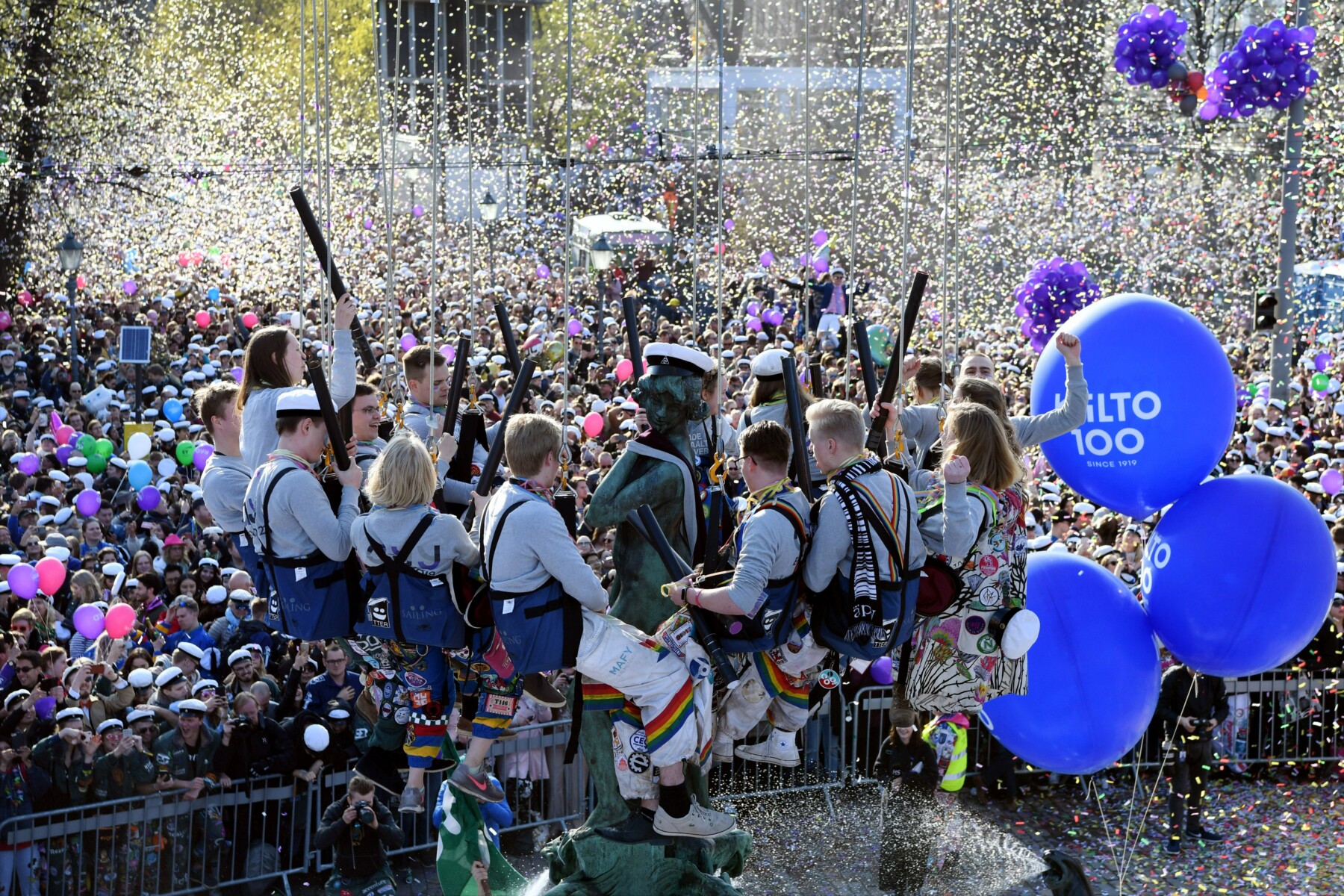In autumn 1908, tempers flared in Helsinki as an artistic controversy – you might even call it a scandal – arose about a new fountain designed by Ville Vallgren (1855–1940).
His elaborate, five-metre-high sculptural fountain featured a Junoesque female nude, surrounded by water-spouting sea lions and fish and a wide circular pool.
The Finnish sculptor had built a bustling career in Paris, where he won a Grand Prix at the 1900 World Exposition. However, he was now being accused of foisting indecent foreign art onto the Finnish public.
Focal point for festivities

Hooray! Every April 30, students in harnesses suspended from a crane crown Havis Amanda with a graduation cap, marking the start of May Day celebrations.Photo: Jussi Nukari/Lehtikuva
Vallgren said that the statue represented a maiden who drowned at sea, arose from it as a mermaid, and was taking her last glance back at the sea. He suggested the Swedish-Latin hybrid name Havis Amanda, meaning “the sea’s beloved.”
“The statue is a symbol of the city,” says Helsinki City Museum architect Mikko Lindqvist. “Helsinki rises from the sea, just as Havis Amanda emerges from the waves in the fountain.”
Early on, a tradition developed of students ceremonially placing a graduation cap on Havis Amanda’s head to kick off festivities for May Day (known as Vappu in Finnish). In recent decades, the site has been a focal point of post-game celebrations whenever Finland wins a big sporting event such as the ice hockey world championship.
[Editor’s note: Finland’s national emojis, originally introduced by ThisisFINLAND, depict such celebrations with “Torilla tavataan” (See you on the square), complete with Havis Amanda and flag-waving fans.]
Swift reactions

Polina Semenova of the Helsinki City Museum is the main conservator in the project to clean and restore Havis Amanda.Photo: Kirsi-Marja Savola
Vallgren cast the bronze sculpture in 1906 in Paris, where it received acclaim at the Salon exhibition before being shipped to Helsinki. There it took pride of place on the harbourside Market Square.
Reactions – pro and con – were swift. Those who defended the monument compared it to Botticelli’s Birth of Venus, which also depicts a female figure just emerged from the sea.
Proto-feminist Lucina Hagman, who had become one the world’s first women MPs in 1907, demanded that the statue be removed, calling it “filthy and lewd.”
Some people complained that it was un-Finnish, pointing to the sea lions and fish as alien species. The female figure was modelled on two Parisiennes.
Just for fun

Children on an outing stop to learn about Havis Amanda.Photo: Martti Kainulainen/Lehtikuva
Eventually nicknamed Manta, this was the first public art of its kind in pre-independence Finland, which was an autonomous grand duchy in the Russian empire prior to 1917.
As the fountain’s main conservator, Polina Semenova of the Helsinki City Museum, puts it, “This was the first statue that was just for fun. That was kind of questionable for some people – like, why are we wasting money on this?”
Lindqvist says, “The work was seen as provocative in 1908, but soon began to be appreciated and adopted by the public. Students gathered to celebrate May Day around Manta, a tradition that’s still ongoing. Fans of ice hockey and other sports also often celebrate international titles around Havis Amanda in carnival style.”
Over the years, sports fans climbing on the statue caused harm to its structure – that’s one reason the artwork is undergoing conservation.
Cleaner air

Polina Semenova and other conservators have had a chance to discover details and nuances around the base of the statue that are normally difficult to see.Photo: Kirsi-Marja Savola
In May 2023, Semenova oversaw the transport of the fountain to a secret location near Helsinki for restoration, including laser cleaning and waxing to protect and restore its dark, uniform colour.
“In the 1970s and ’80s, the patina turned blue and green due to the increased traffic and air pollution,” says Semenova. “Fortunately, the city air has gotten cleaner since then.”
Conserve and protect

The painstaking conservation process keeps Havis Amanda in the shop and away from her usual position on Market Square for more than a year.Photo: Kirsi-Marja Savola
Conservators did not discover any major damage during the restoration process, though they did find scratches and small cracks, as well as a crudely drilled hole near Amanda’s feet, apparently for a long-forgotten lighting project.
“Part of the base, which we call the ‘cake,’ was stretched a bit due to crowds jumping on it, so we welded together some seams to support it,” says Semenova.
“But hopefully people won’t jump on it anymore. It’s going to have a protective wooden sheath around it now whenever there’s a big sports celebration.” What about Vappu? “May Day hasn’t been a problem lately, because it’s well organised and they use a crane to place the traditional student cap on her head.”
More spectacular

Havis Amanda is in one of Finland’s national emojis, “Torilla tavataan,” meaning “See you on the square!” Fans congregate around the statue whenever Finland wins a big sporting event.Emoji illustration: ThisisFINLAND
The fountain reopens in June 2024, possibly with slightly modified nozzles that may spray more water around the fountain.
“If you look at old pictures, the spraying was more spectacular, so that’s what we’re hoping to get back to,” says Semenova.
Conservators found a 1987 class ring wedged into the base, as well as coins from around the world, tossed into the fountain for luck.
Something in her eyes

Having observed Havis Amanda at great length, Polina Semenova says, “I interpret her as a very gentle, soft person.”Photo: Kirsi-Marja Savola
“The cleaning revealed a lot of beautiful nuances, like animals on the base that I’d never noticed before, some kind of squid or octopus,” she says. “We also noticed that two of the fish are obviously meant to be male, and the other two female. These are hidden parts that you can’t normally see, so maybe it was kind of an inside joke.”
Over the winter in the warehouse, Semenova has likely spent more time alone with Manta than anyone since Vallgren. What kind of personality does she sense in this much-debated celebrity?
“I interpret her as a very gentle, soft person,” she says. “It’s something in her eyes, which you can’t usually see so close-up.”
By Wif Stenger, April 2024



